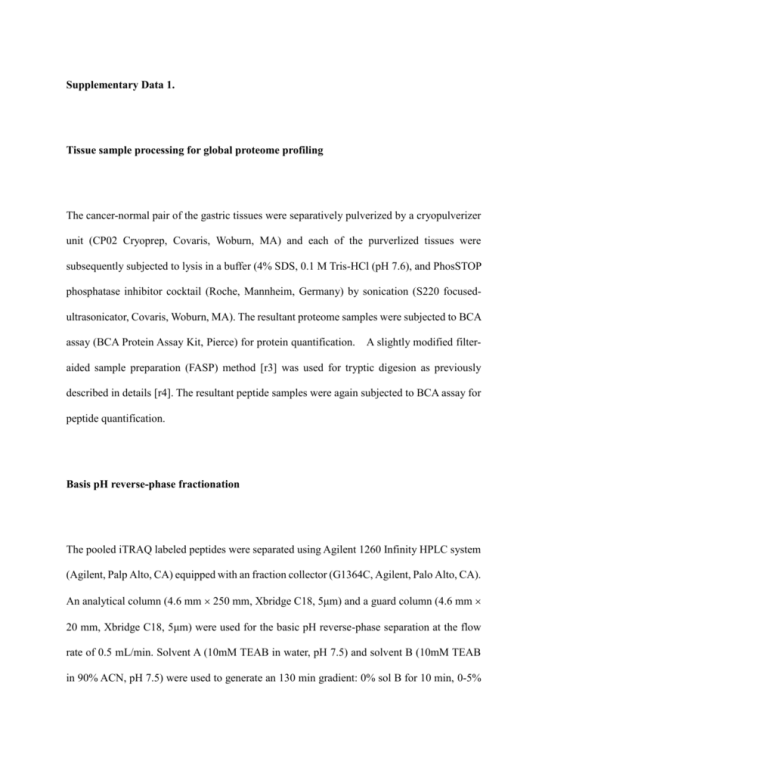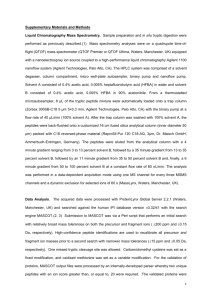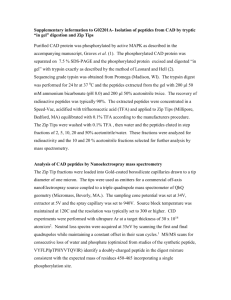pmic7941-sup-0002-SupMat
advertisement

Supplementary Data 1. Tissue sample processing for global proteome profiling The cancer-normal pair of the gastric tissues were separatively pulverized by a cryopulverizer unit (CP02 Cryoprep, Covaris, Woburn, MA) and each of the purverlized tissues were subsequently subjected to lysis in a buffer (4% SDS, 0.1 M Tris-HCl (pH 7.6), and PhosSTOP phosphatase inhibitor cocktail (Roche, Mannheim, Germany) by sonication (S220 focusedultrasonicator, Covaris, Woburn, MA). The resultant proteome samples were subjected to BCA assay (BCA Protein Assay Kit, Pierce) for protein quantification. A slightly modified filter- aided sample preparation (FASP) method [r3] was used for tryptic digesion as previously described in details [r4]. The resultant peptide samples were again subjected to BCA assay for peptide quantification. Basis pH reverse-phase fractionation The pooled iTRAQ labeled peptides were separated using Agilent 1260 Infinity HPLC system (Agilent, Palp Alto, CA) equipped with an fraction collector (G1364C, Agilent, Palo Alto, CA). An analytical column (4.6 mm 250 mm, Xbridge C18, 5μm) and a guard column (4.6 mm 20 mm, Xbridge C18, 5μm) were used for the basic pH reverse-phase separation at the flow rate of 0.5 mL/min. Solvent A (10mM TEAB in water, pH 7.5) and solvent B (10mM TEAB in 90% ACN, pH 7.5) were used to generate an 130 min gradient: 0% sol B for 10 min, 0-5% in 10 min, 5-35 % in 60 min, 35-70 % over 15 min, 70 % for 10 min, 70-0 % over 10min, and holding at 0% over 15 min. A total of 96 fractions were collected in every 1 min from 15 min to 110 min. The 96 fractions were pooled into 24 non-contiguously concatenated peptide fractions as previously described [r5]. The 24 fractions were vacuum dried and stored at –80°C until LC-MS/MS experiments. Capillary RPLC-MS/MS analyses 10 g of labeled peptides from each of 24 fractions were individually analyzed by Q Exactive orbitrap hybrid mass spectrometer (Thermo Scientific, Bremen, Germany) which was coupled to the dual-online LC system through an home-built dual-column nano-electrospray source as previously been described [r4]. The dual-online LC system is equipped with two reversephase analytical columns (75 μm i.d. × 360 μm o.d., 100cm) along with two SPE column (150 μm i.d. × 360 μm o.d., 3cm), that were packed with C18-bonded particles (Jupiter, 3 μm diameter, 300 Å pore size, Phenomenex, Torrance, CA). A linear gradient was applied over 180 min with solvent A (0.1% formic acid in water) and solvent B (0.1% formic acid in ACN) at flow rate of 300 nL/min (1-40 % sol B over 160 min, 40-80 % over 5 min, 80 % for 10 min and holding at 1 % for 5 min). The eluting peptides were ionized at the spray voltage of 2.4 kV and the desolvation capillary temperature of 250 ℃, respectively. MS precursor scans (400 – acquired with the resolution of 70,000 (at 400 Th), followed by data-dependent acquisition of MS/MS data for ten most abundant ions, using higher energy collisional dissociation (HCD) at normalized collision energy (NCE) of 30. MS/MS scans were acquired with fixed first mass of 100 Th with resolution of 17,500 and AGC target value of 1.0106, respectively. The maximum ion injection time of MS scan and MS/MS scan were set to 20 and 60 ms, respectively.







